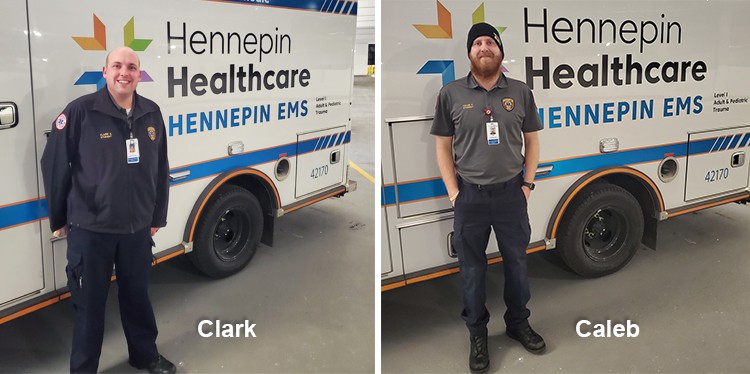New faces in Hennepin EMS

Because of a shortage of emergency medical technicians (EMTs) and paramedics on a state and national level, Hennepin EMS has had to get creative to recruit. The new Hennepin EMS Paramedic Training Program has recruited 24 EMTs (the path to becoming a paramedic starts as an EMT), which started in mid-December, to embark on the rigorous seven-month training program.
What is different about this new program to train a paramedic? The students are paid to be trained and the cost of their training is waived (approximately $10K). In return, the paramedics, upon completion of their academy, commit to three years of employment with Hennepin EMS. The competition was tough to get in the program, but this is a win-win!
Two new recruits, Clark Edblad and Caleb Pesola, agreed to tell their stories. They were interviewed several times during their journey as they carpooled home in the evening together. As with many other trainees, both had different careers leading up to their Hennepin training and became EMTs somewhere along the way. Clark worked at the Medical Examiner’s office in field investigation, at the Minneapolis jail, in probation in Chisago County (which is where he became an EMT), and at the Anoka County Attorney’s office. Always being interested in public service, he wanted to be in more of a lifesaving role than behind a desk.
Caleb studied music in college and interned at a small company as a draftsman. His family has a history of being in public service. He has two brothers who are police officers and a brother in the navy. Caleb, in his younger days, was a Boy Scout and a lifeguard. Also getting tired of sitting behind a desk, he became an EMT and worked for another EMS system.
After weeks of classroom training, the group moves into labs, clinicals, and eventually, ride-alongs. Clinicals involve breaking into small groups that work in areas such as the ED, OB, the OR, or other departments practicing and observing. On ride-alongs, a preceptor is responsible for their training, which can be days, evenings, or nights.
Working in groups gives them exposure to different classmates and backgrounds. The class has a PhD, a criminal defense attorney and a therapist so, per Caleb, “people here are from such diverse backgrounds, we all learn from each other.”
Clark sees, “a great future with Hennepin EMS. There are a lot of opportunities and specializations to discover, like working with partner agencies such as fire departments and Task Force One.” He adds, “Being able to bring some of your classrooms into simulation cases like administering IVs, intubating, and controlling bleeding and hemorrhaging is exciting. You put your learning skills into practice.”
Per Caleb, “I can see staying with Hennepin the duration of my career and supplementing it with being a flight medic or something like that in the future.” Caleb adds, “This is not a small investment Hennepin Healthcare has made in me. I am grateful and I am excited to become a paramedic. If they think I can do it, I know I will.” Clark adds, “The paramedics here got through school so I know if I just take it day by day, I will too. I’m excited, and I feel these paramedics are excited for us too.”

